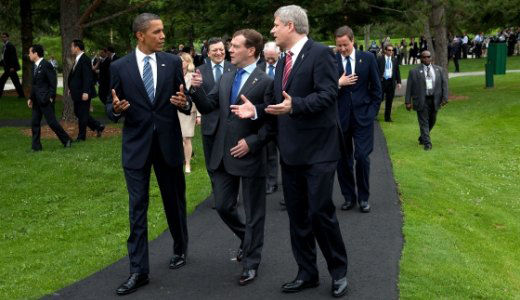
The New START Treaty aimed at reducing U.S. and Russian nuclear stockpiles, signed by President Obama Feb. 2, will come into effect on Saturday. While many, including the president, have pointed out that the treaty is only a step along the road to ridding the world of nuclear weapons, it will, in less than a decade, reduce both nations’ arsenals to their lowest levels since the 1950s.
“Within the next 60 days,” said a letter released by the Friends Committee on National Legislation, “the U.S. and Russia will resume on-site nuclear inspections and resume the process of reducing the number of deployed nuclear weapons in each country’s arsenal.”
Despite shortcomings in the treaty, its ratification during Congress’s lame-duck session was a victory for President Obama and the peace movement. The Republican Party, alarmed at any reduction in the number of American nuclear weapons, fought to scuttle New START.
The agreement, officially the New Strategic Arms Reduction Treaty, will compel Russia and the U.S. to reduce the number of active nuclear warheads to 1,550. According to White House information, “This limit is 74 percent lower than the limit of the 1991 START Treaty and 30 percent lower than the deployed strategic warhead limit of the 2002 Moscow Treaty.”
The 1991 START treaty expired in 2009, and the Moscow Treaty is set to expire in 2012.
In addition, the treaty calls for a combined limit of non-deployed 800 launchers for the warheads. Included under this limit are intercontinental ballistic missiles, submarine launched ballistic missiles and “heavy bombers equipped for nuclear armament.” In addition, 700 deployed missile launchers are allowed – less than half of what was allowed under the 1991 treaty.
The treaty does not, however, rule out “missile defense” systems, ostensibly aimed at protecting the United States from nuclear assaults by foreign powers. However, such defense would require American missiles – the purpose of which would be to intercept ICBMs speeding towards the U.S. – in bases around the world. This is scene by many countries, including Russia and China, as an aggressive move. Russia feels particularly threatened, as the missiles would be placed close to its borders in countries with whom it shares hostile relations.
In a letter to Secretary of Defense Robert Gates, Republican Sens. John Kyl of Arizona, James Risch of Idaho, Mark Kirk of Illinois and James Inhofe of Oklahoma said, “The Republic of Georgia’s geographic location would make it an ideal site for a missile defense radar aimed at Iran.”
Russia fears that such defense systems have as much to do with boxing it in as with any perceived Iranian threat.
Still, most of the world sees New START as a huge step forward.
“This is a salutary achievement, an important step forward towards broader nuclear disarmament and I also welcome President Medvedev’s call for further reductions in stockpiles of strategic weapons,” said Tibor Tóth, Executive Secretary of the Preparatory Commission for the Comprehensive Nuclear Test Ban Treaty Organization.
According to the FCNL, as well as a bipartisan grouping of elected officials, peace advocates and others, is ratification of the Comprehensive Test Ban Treaty, which would, as its name implies, ban any further testing of nuclear weapons.
“The Comprehensive Nuclear Test Ban Treaty bans all nuclear explosions by everyone, everywhere: on the Earth’s surface, in the atmosphere, underwater and underground,” reads an explanation by the CTBT organization, which was set up to prepare for implementation of the CTBT.
The vast majority of states in the world – 182 – have signed on to the CTBT, including the United States. However, only 153 countries have actually ratified it – not including the U.S. And while 153 countries have ratified the treaty, it cannot enter into force until all 44 nations listed in the treaty’s Annex II – those states that possessed nuclear weapons or nuclear reactors as the treaty was being negotiated – ratify.
According to the CTBTO, “Of the 44 countries that have to ratify the treaty for entry into force, 35 have already done so.” Consequently, the world is waiting for those who haven’t signed – China, North Korea, Egypt, India, Indonesia, Iran, Israel, Pakistan and the United States – for the treaty to become effective. Indonesia has recently started the ratification process.
Most of the countries that haven’t signed say that they will do so if the United States does. Consequently, anti-nuclear activists argue that the United States has the power to pave the way for a completely nuclear weapon-free world.
“The Obama Administration will continue to lay the groundwork for positive U.S. Senate consideration of the CTBT, working closely with the Senate, and to bolster international support for the treaty,” Rose Gottemoeller, assistant secretary of the State Department’s arms control bureau, told the international Conference on Disarmament Jan. 27 in Geneva.
But while, according to Gottemoeller, “the Obama Administration will continue to lay the groundwork for positive U.S. Senate consideration of the CTBT,” ratification will be difficult, especially given the results of the 2010 elections. Consequently, say anti-nuclear activists, a stronger grassroots push in support of the CTBT is necessary.
Photo: Whitehouse.gov









